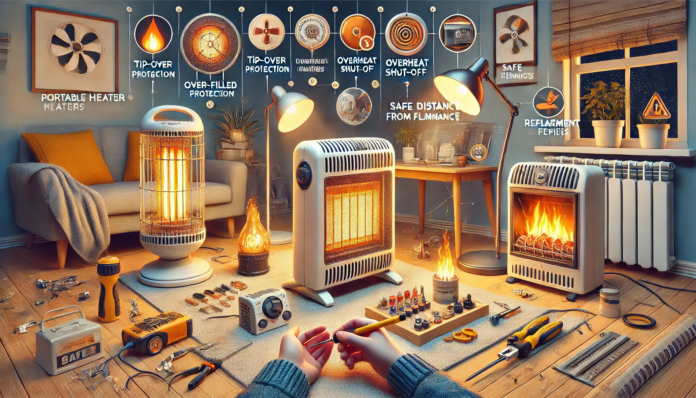Portable heaters are a convenient way to provide warmth in specific areas of your home, especially during colder months. However, they can pose safety risks if not used and maintained correctly. This guide offers essential safety tips and basic repair instructions to help you use portable heaters safely and effectively.
Safety Tips for Portable Heaters
1. Choose the Right Heater
- Type: Select a heater that suits your space and needs. Common types include ceramic, oil-filled, fan-forced, and infrared heaters. Each type has unique features and benefits.
- Safety Features: Look for heaters with built-in safety features such as tip-over protection, overheat shut-off, and cool-touch housing. These features can prevent accidents and injuries.
2. Proper Placement
- Distance from Flammable Materials: Always place the heater at least three feet away from flammable materials, such as curtains, furniture, and paper.
- Stable Surface: Ensure the heater is on a flat, stable surface to prevent tipping. Avoid placing heaters on tables, chairs, or other unstable surfaces.
- Avoid High-Traffic Areas: Place the heater in a low-traffic area to reduce the risk of accidental tipping or tripping over the cord.
3. Safe Usage
- Plug Directly into an Outlet: Avoid using extension cords or power strips, as they can overheat and cause fires. Plug the heater directly into a wall outlet.
- Unattended Use: Never leave a portable heater unattended, especially when sleeping or leaving the room. Always turn off the heater when not in use.
- Supervise Children and Pets: Keep children and pets away from the heater to prevent burns or accidental tipping.
4. Regular Maintenance
- Clean Regularly: Dust and debris can accumulate in the heater, reducing efficiency and increasing the risk of fire. Regularly clean the heater’s exterior and vents.
- Inspect for Damage: Check the heater’s cord, plug, and housing for any signs of damage. Do not use the heater if there are frayed cords, exposed wires, or broken parts.
Repair Guides for Portable Heaters
1. Basic Troubleshooting
- Heater Won’t Turn On: Ensure the heater is properly plugged in and the outlet is functioning. Check the power switch and safety features (such as tip-over protection) to ensure they are not preventing operation.
- Uneven Heating: If the heater is not producing even heat, check for dust buildup or blockages in the vents. Clean the heater and remove any obstructions.
2. Replacing Fuses
- Locate the Fuse: Unplug the heater and locate the fuse compartment, typically at the back or bottom of the unit.
- Remove and Inspect the Fuse: Carefully remove the fuse and inspect it for signs of damage, such as burn marks or a broken filament.
- Replace the Fuse: If the fuse is damaged, replace it with one of the same rating. Never use a fuse with a higher rating, as it can cause damage to the heater or pose a fire hazard.
3. Fixing Loose Connections
- Unplug the Heater: Always unplug the heater before performing any repairs.
- Open the Housing: Use a screwdriver to remove the screws securing the heater’s housing. Carefully open the housing to access the internal components.
- Check Connections: Inspect the wiring and connections for any loose or disconnected wires. Secure any loose connections using wire connectors or electrical tape.
- Reassemble the Heater: Once repairs are complete, carefully reassemble the heater and ensure all screws are securely tightened.
4. Replacing the Heating Element
- Identify the Problem: If the heater is not producing heat, the heating element may be faulty. Confirm this by checking for visible damage or testing continuity with a multimeter.
- Remove the Heating Element: Follow the manufacturer’s instructions to access and remove the heating element.
- Install a New Heating Element: Replace the faulty element with a new one that matches the specifications. Reassemble the heater and test it to ensure proper operation.
Conclusion
Portable heaters can provide effective and convenient warmth when used safely and maintained properly. By following these safety tips and repair guides, you can minimize the risk of accidents and prolong the life of your heater. Always prioritize safety and consult a professional if you’re unsure about performing repairs. Proper usage and regular maintenance can ensure your portable heater remains a reliable source of warmth and comfort during the colder months.
Frequently Asked Questions
What type of portable heater is safest?
The safest portable heaters are those with built-in safety features such as tip-over protection, overheat shut-off, and cool-touch housing. Ceramic and oil-filled heaters are often recommended for their safety features and even heating.
Can I use an extension cord with my portable heater?
It is not recommended to use an extension cord with a portable heater, as it can overheat and pose a fire hazard. Always plug the heater directly into a wall outlet.
How often should I clean my portable heater?
You should clean your portable heater regularly, especially during heavy use periods. Dust and debris can accumulate in the vents and around the heating elements, reducing efficiency and increasing fire risk. Aim to clean the heater at least once a month.
What should I do if my heater’s cord is damaged?
If your heater’s cord is damaged, stop using the heater immediately. A damaged cord can cause electrical shock or fire. Do not attempt to repair the cord yourself; instead, consult a professional or replace the heater.
Is it safe to leave a portable heater on overnight?
It is generally not recommended to leave a portable heater on overnight or unattended. Always turn off the heater when you leave the room or go to sleep to reduce the risk of fire.
How can I tell if my portable heater needs repairs?
Signs that your portable heater may need repairs include the unit not turning on, uneven heating, strange noises, or a burning smell. Additionally, visible damage to the cord, plug, or housing indicates the need for professional inspection and repair.

